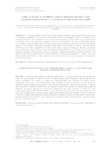Please use this identifier to cite or link to this item:
http://www.alice.cnptia.embrapa.br/alice/handle/doc/1070933| Title: | Agro-climatic suitability and water requirement for Tanzania guineagrass cultivation in the State of Ceará. |
| Authors: | LEMOS, N. L. S.  CAVALCANTE, A. C. R.   SILVA, T. G. F. da   PEZZOPANE, J. R. M.   SANTOS, P. M.   CÂNDIDO, M. J. D.   |
| Affiliation: | Nailson Lima Santos Lemos, Universidade Federal de Sergipe (UFS) - Nossa Senhora da Glória, SE, Brazil; ANA CLARA RODRIGUES CAVALCANTE, CNPC; Thieres George Freire da Silva, Universidade Federal Rural de Pernambuco (UFPE) - Serra Talhada, PE, Brazil; JOSE RICARDO MACEDO PEZZOPANE, CPPSE; PATRICIA MENEZES SANTOS, CPPSE; Magno José Duarte Cândido, Universidade Federal do Ceará (UFC) - Fortaleza, CE, Brazil. |
| Date Issued: | 2017 |
| Citation: | Revista Caatinga, Mossoró, v. 30, n. 4, p. 1028-1039, out./dez. 2017. |
| Description: | Abstracts: This study aimed to define areas suitable, and the irrigation water requirement for, cultivation of Tanzania guineagrass in the state of Ceará, Brazil. Tanzania guineagrass yield was estimated by a mathematical model, which considers the crop actual evapotranspiration, resulting from the crop climatological water balance. The water requirement throughout the year was estimated for soils with a water holding capacity of 20 (shallow soils), 40 (sandy soils), 60 (soils with medium texture) and 100 mm (clay soils). The relative frequency of occurrence of monthly productions greater than 2,750 kg DM ha-1 month-1 was obtained for different areas in Ceará, representative of most of the state's economic mesoregions. Tanzania guineagrass annual yields in the state of Ceará were between 20,000-30,000 kg DM ha-1 year-1 . During the rainy season, the productive potential varies with the economic mesoregion, which presents different climatic conditions. The state of Ceará is only suitable for the rainfed production of Tanzania guineagrass for 4 months each year, predominantly from February to May, while weather conditions do not favor the development of this grass in the remaining months. [Agro-climatic suitability and water requirement for Tanzania guineagrass cultivation in the State of Ceará]. Resumo: O objetivo desse trabalho foi delimitar áreas aptas e o requerimento hídrico de irrigação para cultivo do capim Tanzânia no estado do Ceará. A produtividade do capim Tanzânia foi obtida a partir de um modelo matemático que assume os valores da evapotranspiração real, resultante do balanço hídrico climatológico da cultura. A necessidade hídrica para reposição de água ao longo do ano para solos com capacidade de água disponível de 20 (solos rasos), 40 (solos arenosos), 60 (solos de textura média) e 100 mm (solos argilosos). A partir da TAMS obteve-se a frequência relativa de ocorrência de produtividade mensal em diferentes municípios Cearense. Os valores de produtividade do capim Tanzânia no estado do Ceará predominaram entre 20.000 e 30.000 kg MS ha-1 ano-1. Durante os meses chuvosos o potencial produtivo varia em função da mesorregião econômica, as quais apresentam condições climáticas distintas. Portanto, o estado do Ceará possui aptidão para produção do capim Tanzânia, sob regime de sequeiro, durante apenas quatro meses, predominantemente, de fevereiro a maio, sendo que as condições climáticas não favorecem o desenvolvimento do capim nos demais meses. |
| Thesagro: | Panicum maximum Modelo matemático Gramínea forrageira Matéria seca |
| NAL Thesaurus: | Mathematical models Simulation models Pastures Brazil |
| Keywords: | Capacidade de armazenamento de água Taxa de acúmulo Capim Tanzânia Brasil Ceará Water storage Water requirements |
| Type of Material: | Artigo de periódico |
| Access: | openAccess |
| Appears in Collections: | Artigo em periódico indexado (CNPC)  |
Files in This Item:
| File | Description | Size | Format | |
|---|---|---|---|---|
| CNPC2016Agroclimatic.pdf | 2.2 MB | Adobe PDF |  View/Open |









